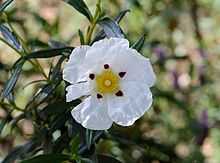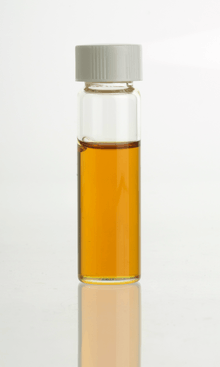Cistus ladanifer
| Gum Rockrose | |
|---|---|
 | |
| Scientific classification | |
| Kingdom: | Plantae |
| (unranked): | Angiosperms |
| (unranked): | Eudicots |
| (unranked): | Rosids |
| Order: | Malvales |
| Family: | Cistaceae |
| Genus: | Cistus |
| Species: | C. ladanifer |
| Binomial name | |
| Cistus ladanifer L. | |
Cistus ladanifer is a species of flowering plant in the family Cistaceae. It is native to the western Mediterranean region. Common names include gum rockrose,[1] Laudanum,[1] Labdanum,[1] common gum cistus,[1] and brown-eyed rockrose.[2]
It is a shrub growing 1–2.5 m (3 ft 3 in–8 ft 2 in) tall and wide. The leaves are evergreen, lanceolate, 3–10 cm long and 1–2 cm broad, dark green above and paler underneath. The flowers are 5–8 cm diameter, with 5 papery white petals, usually with a red to maroon spot at the base, surrounding the yellow stamens and pistils. The whole plant is covered with the sticky exudate of fragrant resin.
C. ladanifer is particularly well suited to the Continentalized Mediterranean climate, standing both long summer droughts and cold weather. It is an extremely aggressive plant which has taken over much of former farmland and grasslands in the mountain regions of central Spain and much of southern Portugal. In Spanish it is known as Jara pringosa meaning "sticky shrub". In Portuguese it is known as "esteva". It has been found to have mycorrhizal associations with Boletus edulis, Boletus rhodoxanthus, and Laccaria laccata.[3]
Systematics and phylogeography
C. ladanifer is placed within the C. salvifolius group within white and whitish pink flowered clade of Cistus species.[4] The wide distribution and morphological variation of C. ladanifer across northern Africa, the Iberian peninsula, and southern France has resulted in the recognition of three sub-species: subspp. ladanifer, sulcatus, and africanus.
Phylogenetic and divergence dating methods found that C. ladanifer diverged during the Pleistocene, long after the opening of the Strait of Gibraltar around 5 mya, which supports a hypothesis of dispersal for this species.[5] Although its seeds fall close to the maternal plant,[6] C. ladanifer may have successfully dispersed due to its preference for disturbed habitats.
Subspecies
- C. ladanifer subsp. ladanifer
- C. ladanifer subsp. mauritianus Pau & Sennen
- C. ladanifer subsp. sulcatus Demoly, syn. C. palhinhae Ingram
Uses

It is a popular ornamental plant, grown for its strongly resin-scented foliage and conspicuous flowers. Its leaves yield a fragrant oleoresin known as labdanum, used in perfumes, especially as a fixative.
This plant has gained the Royal Horticultural Society's Award of Garden Merit.[7]
References
- ↑ 1.0 1.1 1.2 1.3 "USDA GRIN Taxonomy".
- ↑ Hériteau, Jacqueline (2005). Complete Gardening in Southern Africa (second edition ed.). Creative Homeowner. p. 170. ISBN 978-1-58011-259-8.
- ↑ Águeda B, Parladé J, de Miguel AM, Martínez-Peña F. (2006). "Characterization and identification of field ectomycorrhizae of Boletus edulis and Cistus ladanifer". Mycologia 98 (1): 23–30. doi:10.3852/mycologia.98.1.23. PMID 16800301. Retrieved 2009-11-23.
- ↑ Guzman, B., M. D. Lledo, and P. Vargas. 2009. Adaptive Radiation in Mediterranean Cistus (Cistaceae). PLoS ONE 4:e6362.
- ↑ Guzmán, B. and P. Vargas. 2009. Long-distance colonization of the Western Mediterranean by Cistus ladanifer (Cistaceae) despite the absence of special dispersal mechanisms. Journal of Biogeography 36:954-968.
- ↑ Bastida, F. and S. Talavera. 2002. Temporal and spatial patterns of seed dispersal in two Cistus species (Cistaceae). Annals of Botany 89:427-434.
- ↑ http://apps.rhs.org.uk/plantselector/plant?plantid=2453
External links
| Wikimedia Commons has media related to Cistus ladanifer. |